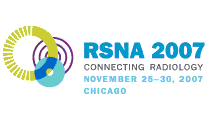
Abstract Archives of the RSNA, 2007
SSK09-06
Fistulography Using Carbon Dioxide in Percutaneous Transluminal Angioplasty for Hemodialysis Access Failure: A Prospective Evaluation
Scientific Papers
Presented on November 28, 2007
Presented as part of SSK09: Vascular/Interventional (Venous Intervention)
Shuji Kariya MD, PhD, Presenter: Nothing to Disclose
Noboru Tanigawa MD, Abstract Co-Author: Nothing to Disclose
Hiroyuki Kojima MD, Abstract Co-Author: Nothing to Disclose
Atsushi Komemushi MD, PhD, Abstract Co-Author: Nothing to Disclose
Yuzo Shomura MD, Abstract Co-Author: Nothing to Disclose
Hiroshi Yamamoto MD, Abstract Co-Author: Nothing to Disclose
Tomokuni Shiraishi, Abstract Co-Author: Nothing to Disclose
Satoshi Sawada MD, Abstract Co-Author: Nothing to Disclose
et al, Abstract Co-Author: Nothing to Disclose
et al, Abstract Co-Author: Nothing to Disclose
To determine whether carbon dioxide (CO2) fistulography can safely guide percutaneous transluminal angioplasty (PTA) for hemodialysis access failure.
141 patients who had hemodialysis access failure were prospectively enrolled in this study from May, 2003 to September, 2004. All cases were performed PTA by using CO2 as first choice contrast agent. CO2 was injected by a power injection at the brachial artery, the draining vein, and the graft. When we could not obtain sufficient information of the vessels by the CO2 fistulography only, iodinated contrast agent was used. The clinical success of PTA was defined as improvement in hemodialysis access failure and as the resumption of normal dialysis after PTA. The patency rates were calculated by Kaplan-Meier method.
The PTA could be performed with only CO2 for 115 of 141 procedures (81.6%), and with CO2 and iodinated contrast agent for 26 of 141 procedures (18.4%). PTA could be performed with only CO2 for 111 of 118 procedures (94.1%) in stenotic lesion, for 0 of 11 procedures (0.0%) in thrombotic obturation, and for 5 of 12 procedures (41.7%) in non- thrombotic obturation. The clinical success rate was 98.6% (139 of 141 patients). Two patients who were performed PTA with CO2 and iodinated contrast agent could not be achieved clinical success. The amount of the CO2 used was 191.2 ± 89.2 ml (range 70-560 ml) per one procedure. In PTA with only CO2, 6-month and 12-month primary patency rates were 60.9% and 43.0%. In all PTA achieved clinical success, 6-month and 12-month primary patency rates were 62.8% and 43.0%. In 3 cases injected CO2 from the brachial artery, transient nausea suggesting CO2 backflow into the carotid artery appeared. The major complications were not observed in all cases.
CO2 fistulography is well tolerated, safe, and adequate for PTA of hemodialysis access failure. PTA by using CO2 contributes to reduce the amount of iodinated contrast agent and it is valuable to keep the remaining renal function.
CO2 fistulography can safely guide PTA for hemodialysis access failure, and it is valuable to keep the remaining renal function because of reducing the amount of iodinated contrast agent.
Kariya, S,
Tanigawa, N,
Kojima, H,
Komemushi, A,
Shomura, Y,
Yamamoto, H,
Shiraishi, T,
Sawada, S,
et al, ,
et al, ,
Fistulography Using Carbon Dioxide in Percutaneous Transluminal Angioplasty for Hemodialysis Access Failure: A Prospective Evaluation. Radiological Society of North America 2007 Scientific Assembly and Annual Meeting, November 25 - November 30, 2007 ,Chicago IL.
http://archive.rsna.org/2007/5016116.html

